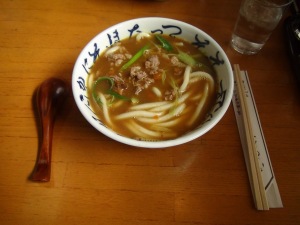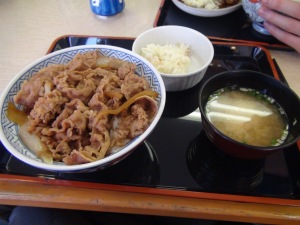For some people, finding food to eat while on holiday can be a chore. For others, it can be an experience by itself. Whichever way you feel about it, finding and ordering food can appear to be a very daunting task, especially when you have no idea what to expect or have difficulty communicating in the local language. Here are a few hints on how to get by without starving to death!
1) FIND RESTAURANTS/CAFES WITH DISPLAYS
You might have come across a local Japanese restaurant in your home country that uses wax models to show how each dish looks. Would it be a shock to you if you found out that a large number of restaurants in Japan actually do have such displays? While you might not know exactly what each dish contains, you can have a pretty good idea of what to expect. One issue however is that you might not be able to read the name of the dish, and might have difficulty conveying to the waiter/waitress the actual dish you are after. I highly recommend bringing a pen and a small notebook and write down the name of the dish as closely as possible, then show it to the waiter/waitress to order.


(The wax model on the left was a pretty good representation of the curry udon!)
2) ASK IF THERE IS AN ENGLISH MENU
A large number of restaurants, particularly those in larger cities or touristy areas, would have English menus available. You can try asking for one in English, though I would recommend trying Japanese instead as part of the experience. To call the waiter/waitress, you should start off by calling out “Sumimasen!” (“excuse me!”). Follow this up by asking “Eigo no menyuu ga arimasuka?”. If they do, he/she would usually reply “Hai” followed up by something along the lines of “Chotto matte kudasai” (“please wait a moment”), or “iie, sumimasen” (“no, sorry). Be understanding if they do not have an English menu (or one in a language from your home country). After all, not all cafes and restaurants in your home country would stock a menu in Japanese.
3) FIND RESTAURANTS WITH PICTURE MENUS
Like with some restaurants in your home country, some in Japan might have a menu which contains pictures of how your dishes might look like. This is especially true for Family Restaurants along the likes of Denny’s, Gusto, and Royal Host. These places would usually have a copy of the menu available at the counter or on the front door, so you can have a quick look before being seated.
4) EXPLORE CONVENIENCE STORES AND SUPERMARKETS
If you are okay with having meals on the go and not having a proper sitting dinning experience, an option would be to explore convenience stores and supermarkets. Many would have a large range of reasonably priced bento (takeaway meals), onigiri, sushi, bread, takoyaki etc. Bakeries are another option.
5) THE LAST RESORT – FAST FOOD
Worst comes to worst, there are always fast food joints. Personally I am against having burgers in foreign countries when there is so much local food to enjoy. However sometimes when I am too tired or in cases where it is more convenient, there is an abundance of fast food to fall back on. A popular type of Japanese fast food is gyudon (beef bowls). There are many establishments which sell gyudon, including the likes of Yoshinoya and Sukiya, and are usually located near train stations. Many of these places would have picture menus available. An added bonus is that these places are usually very cheap, though don’t expect it to be a well balanced meal (notice the lack of greens).
If you wish to go for Western style fast food, at least go to a Japanese chain like Mos Burger or Lotteria. McDonals and KFC are available, but if you can get them in your home country, why bother eating them in Japan? Ordering can be tricky, as even though some places may have English menus, the cashier may not understand what you are asking for. Most places would usually have a small menu at the counter, which allows foreigners to point to the meal they want. Others would have a number associated with the meal, so stating the number to the cashier is sufficient. To say this in Japanese, it is “(meal number in Japanese) ban kudasai” (holding up your fingers might help too). The cashier will likely then ask if you want the “set” (listen to the world “setto” – this has the same meaning as “combo” in most places in the world), to which a simple “hai” or “iie” is sufficient.
6) …WHY IS THERE A VENDING MACHINE HERE?
At times, you may find that there are vending machines at the front of the shop which you need to purchase your meal tickets from before you sit down at a table. This is to improve efficiency and reduce the number of staff required. Most will likely have a picture of the food item which you want to purchase. Others will have the name of the food item, in which case you should note down the number of the dish you want to order before using the vending machine.
7) SO MANY THINGS I WANT TO TRY…BUT WHERE CAN I TRY IT?
Finding a place that sells a certain type of you that you want to try can be quite difficult if you are going off the bat. Common food like ramen, gyudon, and general types of donburi (rice bowls) are easy to find. However, finding a good okonomiyaki store, a cheap but good place for Kobe beef, or a nearby family restaurant can be much harder. Thankfully, being as efficient a country that Japan is, they have a website called Gurunavi. There is an English version which allows you to find the perfect place you are looking for, shows a map of where the establishment is located, and also a general price range so that you have an idea of how much to spend. There is also an option to select only vegetarian food, which will be helpful to some. Some of the listings also have a menu available in English. If you can read Japanese, switch to the Japanese language option, as it is usually more indepth on there. Of course, Gurunavi does not list every restaurant, and sometimes doing a quick search online may yield better options. Alternatively Japan-Guide, WikiTravel and Lonely Planet have some recommendations as well.
DON’T WORRY – JUST EAT!
It is not as daunting to find and order food in Japan compared to many other foreign places in the world. Just chill out and relax. There is always an option that will suit you perfectly. Remember to bring pen and a small notebook and you should be fine. Even if you end up stuffing up your order and ending up with something you do not want, you may end up enjoying your experience more because of it. Be adventurous and have a great time.












